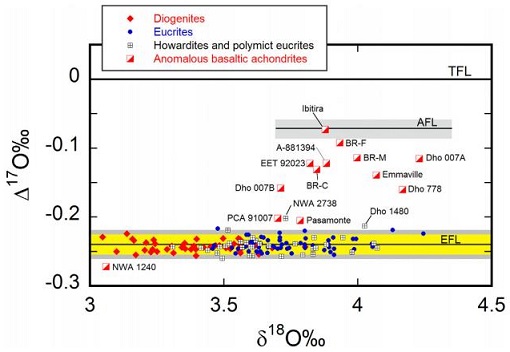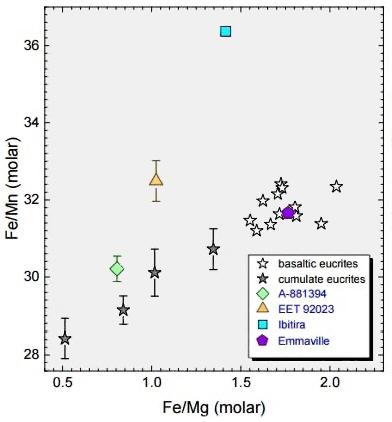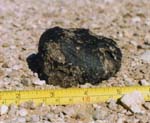EucriteMost common type of achondrite meteorite and a member of the HED group. Eucrites are basalts composed primarily of pigeonite and anorthite (An60-98). Eucrites have been placed into three subgroups based on mineralogical and chemical differences. • Non-cumulate eucrites represent the upper crust that solidified on a magma ocean after Click on Term to Read More
Polymict brecciaGeneral term for all breccias that are neither monomict nor dimict. Modified from image source: http://www.saharamet.com/meteorite/gallery/HED/index.html., cumulateIgneous rock composed of crystals that have grown and accumulated (often by gravitational settling) in a cooling magma chamber. Click on Term to Read More
(or mesosideriteOne of two main types of stony-iron meteorite, the other being pallasites. Mesosiderites are a mixture of approximately 50% basaltic, gabbroic and orthopyroxenitic silicates and 50% Ni-Fe metal and sulfides. The name derives from the Greek "mesos" meaning "middle" or "half" and "sideros" for "iron;" hence "half-iron". The silicates are Click on Term to Read More inclusionFragment of foreign (xeno-) material enclosed within the primary matrix of a rock or meteorite. Click on Term to Read More)

Found 1999
18° 20.1′ N., 54° 10.9′ E.
This coarse-grained, brecciated
eucriteMost common type of achondrite meteorite and a member of the HED group. Eucrites are basalts composed primarily of pigeonite and anorthite (An60-98). Eucrites have been placed into three subgroups based on mineralogical and chemical differences. • Non-cumulate eucrites represent the upper crust that solidified on a magma ocean after Click on Term to Read More, with a total known weight of ~27 kg, was found broken into 37 fragments on the desert floor of Oman. The
findMeteorite not seen to fall, but recovered at some later date. For example, many finds from Antarctica fell 10,000 to 700,000 years ago. Click on Term to Read More site is a flat plain, covered with
carbonateMineral or compound containing carbon and oxygen (i.e. calcium carbonate, CaCO3, calcite). Click on Term to Read More stones, interspersed with a quartz–carbonate sand. The area is overgrown by low shrubs. Based on structure, petrography, bulk chemistry, and
REEOften abbreviated as “REE”, these 16 elements include (preceded by their atomic numbers): 21 scandium (Sc), 39 Yttrium (Y) and the 14 elements that comprise the lanthanides excluding 61 Promethium, an extremely rare and radioactive element. These elements show closely related geochemical behaviors associated with their filled 4f atomic orbital. Click on Term to Read More patterns, this eucrite was classified as a cumulate by Dr. Marina Ivanova at the Vernadsky Institute of
GeochemistryStudy of the chemical composition of Earth and other planets, chemical processes and reactions that govern the composition of rocks and soils, and the cycles of matter and energy that transport Earth's chemical components in time and space. Click on Term to Read More of the Russian Academy of Sciences, Moscow.
In contrast to noncumulate
eucritesMost common type of achondrite meteorite and a member of the HED group. Eucrites are basalts composed primarily of pigeonite and anorthite (An60-98). Eucrites have been placed into three subgroups based on mineralogical and chemical differences. • Non-cumulate eucrites represent the upper crust that solidified on a magma ocean after Click on Term to Read More, cumulate eucrites have higher Mg contents (Mg# ~44–65), REE abundances much lower than chondritic, and are LREE-enriched with positive Eu anomalies (18–23 × CI). The source
magmaMolten silicate (rock) beneath the surface of a planetary body or moon. When it reaches the surface, magma is called lava. Click on Term to Read More was probably derived from the
mineralInorganic substance that is (1) naturally occurring (but does not have a biologic or man-made origin) and formed by physical (not biological) forces with a (2) defined chemical composition of limited variation, has a (3) distinctive set of of physical properties including being a solid, and has a (4) homogeneous Click on Term to Read More peridotite, a mixture of
olivineGroup of silicate minerals, (Mg,Fe)2SiO4, with the compositional endpoints of forsterite (Mg2SiO4) and fayalite (Fe2SiO4). Olivine is commonly found in all chondrites within both the matrix and chondrules, achondrites including most primitive achondrites and some evolved achondrites, in pallasites as large yellow-green crystals (brown when terrestrialized), in the silicate portion Click on Term to Read More,
pigeoniteLow-Ca clinopyroxene, (Ca,Mg,Fe)SiO3, found as a major mineral in eucrites and shergottites. In order to be considered pigeonite, the clinopyroxene must contain 5 to 20 mol % of calcium (Wo5 - 20). Chondrites of petrologic types 4 and below contain significant low-Ca clinopyroxene. During metamorphism to higher temperatures, all existing, and
plagioclaseAlso referred to as the plagioclase feldspar series. Plagioclase is a common rock-forming series of feldspar minerals containing a continuous solid solution of calcium and sodium: (Na1-x,Cax)(Alx+1,Si1-x)Si2O8 where x = 0 to 1. The Ca-rich end-member is called anorthite (pure anorthite has formula: CaAl2Si2O8) and the Na-rich end-member is albite Click on Term to Read More, and is the mineral forming the bulk of the Earth’s upper
mantleMain silicate-rich zone within a planet between the crust and metallic core. The mantle accounts for 82% of Earth's volume and is composed of silicate minerals rich in Mg. The temperature of the mantle can be as high as 3,700 °C. Heat generated in the core causes convection currents in Click on Term to Read More. Cumulate eucrites formed by
fractional crystallizationA crystallization process in which minerals crystallizing from a magma are isolated from contact with the liquid. It is a key process in the formation of igneous rocks during the process of magmatic differentiation. Also known as crystal fractionation. Click on Term to Read More in a magma chamber about 4.5 b.y. ago. On the basis of
augiteHigh-Ca clinopyroxene, (Ca,Mg,Fe)SiO3, that occurs in many igneous rocks, particularly those of basaltic composition. In order to be considered augite, the clinopyroxene must contain 20 to 45 mol % of calcium (Wo20 - 45). An important and unique Martian meteorite is NWA 8159, that has been classified as an augite basalt. Click on Term to Read More lamellae widths and Ca zoning profiles, a burial depth for cumulate eucrites was calculated to be 7–8 km, with a cooling rate of 0.16–0.2°C/t.y.
The composition of Dhofar 007 consists of roughly equal proportions of
anorthiteRare compositional variety of plagioclase and the calcium end-member of the plagioclase feldspar mineral series with the formula CaAl2Si2O8. Anorthite is found in mafic igneous rocks such as anorthosite. Anorthite is abundant on the Moon and in lunar meteorites. However, anorthite is very rare on Earth since it weathers rapidly Click on Term to Read More, a Ca-rich plagioclase
feldsparAn alumino-silicate mineral containing a solid solution of calcium, sodium and potassium. Over half the Earth’s crust is composed of feldspars and due to their abundance, feldspars are used in the classification of igneous rocks. A more complete explanation can be found on the feldspar group page. Click on Term to Read More, and the clinopyroxenes pigeonite and augite, along with minor amounts of Fe-metal,
troiliteBrass colored non-magnetic mineral of iron sulfide, FeS, found in a variety of meteorites. Click on Term to Read More,
chromiteBrownish-black oxide of chromium and iron (Cr-Fe oxide), Cr2FeO4, found in many meteorite groups. Click on Term to Read More, and phosphates. Glassy melt-veins pervade these components, reflecting an impact-shock history. During studies of Dhofar 007 by Yamaguchi
et al (2003), they identified various xenolithic inclusions, including a polymineralic impact-melt
clastA mineral or rock fragment embedded in another rock. Click on Term to Read More, a Mg-rich
orthopyroxeneOrthorhombic, low-Ca pyroxene common in chondrites. Its compositional range runs from all Mg-rich enstatite, MgSiO3 to Fe-rich ferrosilite, FeSiO3. These end-members form an almost complete solid solution where Mg2+ substitutes for Fe2+ up to about 90 mol. % and Ca substitutes no more than ~5 mol. % (higher Ca2+ contents occur Click on Term to Read More fragment, and a recrystallized plagioclase grain, demonstrating a polymict nature for this
meteoriteWork in progress. A solid natural object reaching a planet’s surface from interplanetary space. Solid portion of a meteoroid that survives its fall to Earth, or some other body. Meteorites are classified as stony meteorites, iron meteorites, and stony-iron meteorites. These groups are further divided according to their mineralogy and Click on Term to Read More.
Another clast that was studied which represents a large portion of this meteorite is coarse-grained with a granular texture, composed primarily of equal amounts of
pyroxeneA class of silicate (SiO3) minerals that form a solid solution between iron and magnesium and can contain up to 50% calcium. Pyroxenes are important rock forming minerals and critical to understanding igneous processes. For more detailed information, please read the Pyroxene Group article found in the Meteoritics & Classification category. Click on Term to Read More (pigeonite and augite) and plagioclase, along with minor
silicaSilicon dioxide, SiO2. and metallic phases. The derivation of the metallic phases is suggested by Yamaguchi
et al. (2006) to have occurred through the injection of a metallic component during a high temperature impact-shock event on the mesosiderite
parent bodyThe body from which a meteorite or meteoroid was derived prior to its ejection. Some parent bodies were destroyed early in the formation of our Solar System, while others like the asteroid 4-Vesta and Mars are still observable today. Click on Term to Read More. They describe a scenario by which the eucrites were formed at a distance from the actual impact location of a large metallic projectile, while the mesosiderites were located in close proximity to the impact. Dhofar 007 is unusually enriched in siderophile elements, including Ni, Ir, Os,
AuThe astronomical unit for length is described as the "mean" distance (average of aphelion and perihelion distances) between the Earth and the Sun. Though most references state the value for 1 AU to be approximately 150 million kilometers, the currently accepted precise value for the AU is 149,597,870.66 km. The Click on Term to Read More, Pd, and Co, similar to the abundances found in
metalElement that readily forms cations and has metallic bonds; sometimes said to be similar to a cation in a cloud of electrons. The metals are one of the three groups of elements as distinguished by their ionization and bonding properties, along with the metalloids and nonmetals. A diagonal line drawn Click on Term to Read More of mesosiderites. The
platinum group elementsElements with geochemical properties similar to Pt (platinum) including Ru, Rh, Pd, Os, Ir, and sometimes Au. These occur in nature in close association with one another and with Ni and Cu. They are among the least abundant of the Earth’s naturally occurring elements. Click on Term to Read More also have ratios that are similar to those in metallic portions of mesosiderites.
Compared to cumulate eucrites, the cooling history of Dhofar 007 is more complex. Following the shock-heating/melting event in which FeNi-metal was injected, recrystallization occurred. Thereafter, excavation from depth caused very rapid cooling at high temperatures (850–1200°C) in pyroxenes, resulting in the formation of very thin augite
exsolutionSegregation, during cooling, of a homogeneous solid solution into two or more different solids. Click on Term to Read More lamellae. This cooling rate is on the order of 10,000 times higher than that of cumulate eucrites cooled at depth. Subsequent burial by an extensive
ejecta blanketGenerally symmetrical apron of ejecta surrounding a crater; it is thick at the crater's rim and thin to discontinuous at the blanket's outer edge. Click on Term to Read More led to very slow cooling at lower temperatures (~700°C down to at least 300°C) as evidenced by the metallic phases, in a similar manner to that of mesosiderites. Later, moderate impact-shock events produced
brecciationThe formation of a breccia through a process by which rock fragments of of various types are recemented or fused together. Click on Term to Read More and melt veins. Based on these anomalies in siderophile content and cooling history, Yamaguchi
et al. (2003, 2006) proposed that Dhofar 007 might possibly be a
silicateThe most abundant group of minerals in Earth's crust, the structure of silicates are dominated by the silica tetrahedron, SiO44-, with metal ions occurring between tetrahedra). The mesodesmic bonds of the silicon tetrahedron allow extensive polymerization and silicates are classified according to the amount of linking that occurs between the fraction from a mesosiderite.
Despite these anomalies, the
petrologyScience dealing with the origin, history, occurrence, chemical composition, structure and classification of rocks. Click on Term to Read More, REE content, Mg#, FeO/MnO ratios, mineralogy, and textures are all consistent with a cumulate eucrite classification. However, utilizing an
oxygenElement that makes up 20.95 vol. % of the Earth's atmosphere at ground level, 89 wt. % of seawater and 46.6 wt. % (94 vol. %) of Earth's crust. It appears to be the third most abundant element in the universe (after H and He), but has an abundance only Click on Term to Read More three-isotope diagram, Greenwood
et al. (2017) demonstrate that Dhofar 007 plots far away from the eucrite
fractionationConcentration or separation of one mineral, element, or isotope from an initially homogeneous system. Fractionation can occur as a mass-dependent or mass-independent process. Click on Term to Read More line (see diagram below). Whether this reflects impactor contamination on the eucrite parent body (4
VestaThird largest and fourth brightest asteroid; it was discovered in 1807 by Heinrich Olbers and named for the ancient Roman goddess of the hearth. 4 Vesta has a basaltic surface composition and an average density not much less than that of Mars. Evidently lava once flowed here indicating that the) or a separate parent body is still an open question.

Diagram credit: Greenwood
et al.,
Chemie der Erde, vol. 77, p. 25 (2017)
‘Melting and differentiationA process by which a generally homogeneous chondritic body containing mostly metal, silicates and sulfides will melt and form distinct (differentiated) layers of different densities. When the melting process continues for a long enough period of time, the once chondritic body will re-partition into layers of different composition including Click on Term to Read More of early-formed asteroids: The perspective from high precision oxygen isotopeOne of two or more atoms with the same atomic number (Z), but different mass (A). For example, hydrogen has three isotopes: 1H, 2H (deuterium), and 3H (tritium). Different isotopes of a given element have different numbers of neutrons in the nucleus. Click on Term to Read More studies’
(open access: http://dx.doi.org/10.1016/j.chemer.2016.09.005) The unbrecciated eucrite-like
achondriteAn achondrite is a type of stony meteorite whose precursor was of chondritic origin and experienced metamorphic and igneous processes. They have a planetary or differentiated asteroidal origin where the chondritic parent body reached a sufficient size that through heating due to radioactive decay of 26Al (aluminum isotope) and gravitational Click on Term to Read More EET 92023 exhibits important petrological and O-isotopic similarities to the coarse-grained clasts in Dhofar 007, and it has been considered that the two might be genetically related. In their study of EET 92023, Yamaguchi
et al. (2017) determined that its source rock experienced a multistage thermal history including a very early impact by a IAB or IVA iron projectile, but evidence indicates that its anomalous O-isotopic signature is indigenous rather than the result of impactor contamination. It has not yet been determined if the similar O-isotopic signature of Dhofar 007 is also indigenous or is instead due to impactor contamination.
In addition to Dhofar 007 and EET 92023, a number of anomalous eucritic meteorites are known including Ibitira, Pasamonte, NWA 1240, PCA 82502/91007, Bunburra Rockhole, A-881394, and Emmaville, each of which are resolved from typical eucrites and the HED parent body both isotopically and compositionally. It is notable that EET 92023, Bunburra Rockhole, and A-881394 have close O-isotope values, which suggests the possibility of a genetic relationship (Barrett
et al., 2017,
O-isotopic diagram 1; Mittlefehldt
et al., 2018,
O-isotopic diagram 2).
Another useful tool to help resolve potential genetic relationships among meteorites is the Fe/Mn ratio. While Fe and Mn do experience nebular fractionations, they are not readily fractionated during parent body igneous processing, and therefore different Fe/Mn values are inherent in different parent objects. Mittlefehldt
et al. (2017) utilized a number of eucrites and anomalous eucrite meteorites, including A-881394, EET 92023, Ibitira, and Emmaville, to compare the Fe/Mn and Fe/Mg ratios for low-Ca pyroxenes. Contrary to the results from O-isotopic analyses, these four meteorites plot in separate locations on an Fe/Mn
vs. Fe/Mg coupled diagram, which suggests that they derive from separate parent bodies (see diagram below). Moreover, although Bunburra Rockhole and A-881394 have overlapping oxygen and chromium isotope compositions, new in-depth analyses of Bunburra Rockhole conducted by Benedix
et al. (2017, and references therein) have revealed that these two meteorites have very different textures and mineral chemistries;
e.g., Bunburra Rockhole has plagioclase with An
87–
90, while A-881394 has plagioclase with An
98. Based on their results, they consider it likely that these two meteorites derive from separate parent bodies. Further details about the anomalous eucrites can be found on the
Pasamonte page.

Diagram adapted from Mittlefehldt
et al., 47th LPSC,
#1240 (2016) Based on the calculated CRE age and Kr–Kr age of ~12–15 m.y., a terrestrial age for Dhofar 007 has been estimated to be 70 t.y. (Takeda
et al., 2007). A previous estimate given by Miura and Nagao (2003) was 20 t.y. Further information about the cumulate eucrites can be found on the
NWA 1836 page. The photo above shows a 1.45 g partial end section of Dhofar 007 showing both fine- and coarse-grained clasts intruded by black shock veins. The photo below shows one of the fusion-crusted fragments as it was found lying on the desert plain.











